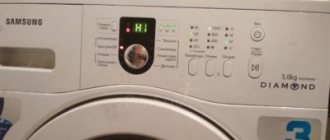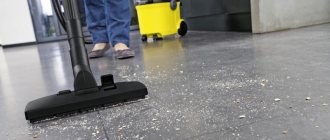You open the dishwasher door, and instead of clean and shiny plates, there are still dirty dishes with food residues and soap stains. Sound familiar? The spectacle, of course, is unpleasant and sad. But don’t rush to look for signs of a malfunction in your “assistant” - it is likely that the problem is caused by trivial reasons that can be eliminated yourself!
Problems associated with incorrect use of the dishwasher
- Leftover food and dried food. If you do not remove all this from the dishes, then the quality of washing will never be ideal. All manufacturers warn about this rule, and it is recommended to follow it.
- Incorrect mode selection. Economy and short programs are intended only for light soiling, while greasy dishes require the longest cycle at the highest temperature.
- Machine overload. If your dishwasher isn't cleaning dishes well, you may be loading too many dishes and other utensils into the dishwasher. Try putting in fewer dishes next time - most likely your problem will be solved.
- Incorrect use of detergents. The wrong choice of cleaning chemicals and/or their quantity is a common reason for poor dishwasher performance. Try decreasing or increasing the amount of rinse aid, or even changing its brand.
If all these manipulations did not lead to a positive result, and your dishwasher still does not wash dishes well, then you will have to get to know it better. Or rather, with its internal structure. Some problems arise as a result of regular use of the dishwasher and can easily be solved without the involvement of specialists.
Dishes are poorly washed in the PMM
The dishwasher may not cope with its tasks for a number of reasons, including:
- incorrect placement of dishes in the chamber;
- device overload;
- incorrect choice of washing program;
- errors in the selection of household chemicals;
- lack of car maintenance;
- technical issues.
To find out why the equipment washes poorly, it is necessary to diagnose it. For this purpose, most models provide a special program. The error code displayed on the panel can be deciphered using the user manual. There you will also find troubleshooting solutions.
Expert opinion
I work in the household appliance repair industry. Extensive experience in restoring washing machines and dishwashers.
Ask a Question
Some problems can be solved on your own. To repair serious damage, you will have to contact specialists.
Problems associated with active use
- Scale. Perhaps this is one of the most insidious enemies of dishwashers. Scale appears due to hard water (even despite the use of special softeners), it is not visible on the plastic parts of the equipment, but inside, where the parts are metal, the scale slowly does its job. When deposited on the spray arms, scale prevents water from spraying, and, as a result, the dishwasher does not wash dishes well. To eliminate this problem, you need to pour citric acid into the machine instead of detergent and run it in idle mode at maximum temperature.
- Blockages. The cause of blockages is food debris, particles of napkins and other debris that gets into the machine on dishes. As a rule, coarse and fine filters, as well as sprinklers, are most susceptible to this “disease”. Therefore, if suddenly your dishwasher begins to wash dishes poorly after many months of good operation, first of all you should check the filters. Continue to clean them after each use of the dishwasher, as the manufacturers recommend.
So, the filters are cleaned, the amount of detergent is adjusted by milliliters, the correct mode is selected, and you scraped the dried dirt off the dishes - but the dishwasher does not wash the dishes as before! It looks like you've encountered a really serious problem. Well, look for its signs in the table below.
When you can’t do without the help of a specialist
The above mentioned are the faults that, in principle, can be fixed with your own hands, but there are also a number of complex breakdowns. To eliminate them, you will have to contact the service department and call a specialist to your home, since performing maintenance or repairs requires knowledge of the procedure for disassembling the machine and removing defective components. At the same time, a specialist can diagnose PMM.
To eliminate complex breakdowns, you will have to contact the service department and call a specialist to your home.
Circulation pump malfunction
If this unit breaks down, the water supply is blocked, and as a result, the dishwashing process stops. In such a situation, there is only one way out - replacing it. To maintain the efficiency of the dishwasher, it is worth installing, so to speak, a native, suitable pump.
If the circulation pump breaks down, the water supply is blocked and, as a result, the dishwashing process stops.
Control module operation error
The basic task of this device is to control the operation of the machine. And at the slightest malfunction, interruptions begin in the work. This problem can only be resolved by replacing the control module.
This problem can only be resolved by replacing the control module.
Broken recirculation pump
The task of this device is to pump water into the system and supply it to the working chamber. When it breaks down, the water pressure in the machine drops and it stops working. The way out of this situation is quite simple - replacement or repair, but you should not do this yourself.
If the recirculation pump breaks down, the water pressure in the machine drops and it stops working.
Failure or malfunction of the software module
The memory of this device contains programs necessary for the efficient operation of the machine. Even a small malfunction in its operation leads to program errors, that is, the operating modes are distorted, which certainly affects the quality of washing kitchen utensils. What to do if your dishwasher doesn't wash dishes well? There are two methods - either repairing the module or replacing it.
The memory of the device's software module contains programs necessary for the efficient operation of the machine.
Burnt out heating element (water heater)
Sometimes, for various reasons, the heating element stops working. As a rule, this is due to the fact that scale has accumulated on its surface. It makes it difficult to transfer heat, and for full operation the heating element must consume more energy. In the end, he simply burns out. This unit cannot be repaired, and therefore it is simply replaced.
The heating element cannot be repaired, and therefore it is simply replaced.
Damage to the water turbidity sensor in the dishwasher
Such an indicator is installed in advanced PMMs, for example, Bosch, Indesit and other quite expensive models. Its task is to monitor water quality. When a certain level of water turbidity is reached, it transmits a corresponding signal to the controller. And if the Bosch dishwasher does not wash dishes well because of this, then there is only one way out - replacing the sensor.
The purpose of a water turbidity sensor is to monitor water quality.
Sprinkler impeller failure
An impeller is a device necessary for spraying water in the working chamber. If it fails, water stops flowing normally and the quality of washing tends to zero. The solution is to change this node.
An impeller is a device necessary for spraying water in the working chamber.
Thermal relay burnt out
The key mission of this indicator is to monitor the heating level of water supplied for washing kitchen utensils. It transmits this information to the control unit, which decides whether to continue heating or stop. If the indicator fails, the dishes will be washed in cold water, and this will negatively affect the quality of the wash. It needs to be replaced.
If the indicator fails, the dishes will be washed in cold water, and this will negatively affect the quality of the wash.
If the dishwasher does not wash dishes, you must remember that this is a rather complex device, and its operation requires strict adherence to the instructions. You should not replace worn or broken components yourself; such work requires certain knowledge and special skills. In addition, you may need a special tool that is used only for repairing the PMM, and disassembling the machines yourself may lead to the need to either send it for major repairs or dispose of it.
Poorly washes dishes on the top shelf
Users note that dishes located on the top shelf of the chamber are washed worse than the rest of the volume. This may occur due to the fact that objects on the middle and lower shelves block water from accessing the top one. And also in such a situation, it is worth checking the upper rocker for blockages.
Arrange kitchen appliances, keeping a small space between them, in accordance with the diagram given in the instructions. Do not exceed the recommended load and ensure that all items drain well. Do not place dishes that are not machine washable in the chamber.
There is a residue left on the dishes
Sometimes, over time, a certain residue appears on the dishes. To get rid of it and prevent new troubles from arising, you need to:
- monitor the amount of regenerating composition;
- select the appropriate washing mode and adjust the salt supply in accordance with the water hardness;
- clean the internal parts of the machine from scale;
- Use detergents recommended by the equipment manufacturer and follow their dosage.
When filling the salt container, be careful. The lid of the tank must be closed tightly, otherwise the substance will enter the washing chamber, and this in turn will lead to the appearance of deposits on the dishes.
dish basket
Causes of malfunction and what to do
Incorrect operation
Dishwasher owners usually make the following mistakes when using their appliances:
- Kitchenware is not prepared for loading. To obtain a satisfactory washing result, plates must be cleared of food debris and napkins. Failure to follow this rule will lead not only to unwashed dishes, but also to clogged filters.
- The washing program is selected incorrectly. When loading a large volume of heavily soiled dishes, select a long high-temperature mode.
- Kitchen utensils are placed in the washing chamber haphazardly and too tightly. There must be a certain distance between the dishes; the hopper must not be overloaded.
- Unsuitable household chemicals are used. Try replacing your powder or tablets with a new product or adjusting your dose.
Expert opinion
I work in the household appliance repair industry. Extensive experience in restoring washing machines and dishwashers.
Ask a Question
The operating rules for the device are described in detail in the attached instructions.
Blockage
Filters and small holes in various parts of the machine become clogged due to the user not properly cleaning the plates before loading them into the hopper. To eliminate this problem, you need to remove the parts and wash them under running water. You can remove small debris from the holes using toothpicks.
Manufacturers of PMM recommend regularly washing filters so that the quality of washing does not deteriorate and the equipment does not break down.
Clogged dishwasher
Late cleaning of parts
The external surfaces and internal parts of the machine must be kept clean. In addition to filters and sprayers, thoroughly clean the chamber walls. To do this, first remove the baskets from it and soak them in a container with hot water and detergent. After this procedure, traces of grease and other contaminants will be washed off more easily. Then wipe the clean baskets dry and put them back in place.
The tubular electric heater also needs to be cleaned to remove scale and dirt. But this is only possible in older models, when it was located in the chamber.
Small particles of debris accumulate in the rubber door seal. You can clean it with a toothbrush and detergent.
Manufacturers recommend wiping all accessible surfaces of the dishwasher with a dry cloth after each operating cycle. Do not forget to ventilate the bunker and periodically leave the door open.
Using cheap detergents
Companies that produce household kitchen appliances provide recommendations to users regarding cleaning products. The use of cheap products or their incorrect dosage impairs the performance of the device and has a negative impact on the washing result.
The appearance of scale on dishwasher parts
Even if you use regenerating salt in your PMM properly, hard water scale may form on metal parts. Limescale gradually closes the holes in the filters and sprayers and clogs the drain hose.
To eliminate this problem, experts recommend periodically running a dry wash at high temperature, adding citric acid rather than detergent. Inexpensive but effective substance copes well with deposits.
Limescale
Incorrectly set operating mode
Premium smart dishwashers are equipped with a function that automatically detects the desired program. The equipment independently selects the water temperature, cycle duration and washing intensity.
If your machine does not have these technical capabilities, choose the mode correctly so as not to overload the device and waste unnecessary resources. Consider the volume of dirty dishes and the degree of soiling.
Expert opinion
I work in the household appliance repair industry. Extensive experience in restoring washing machines and dishwashers.
Ask a Question
Remember that the short economy mode is more suitable for refreshing dishes. A mountain of accumulated plates with dried food remains will not be washed under such conditions.











